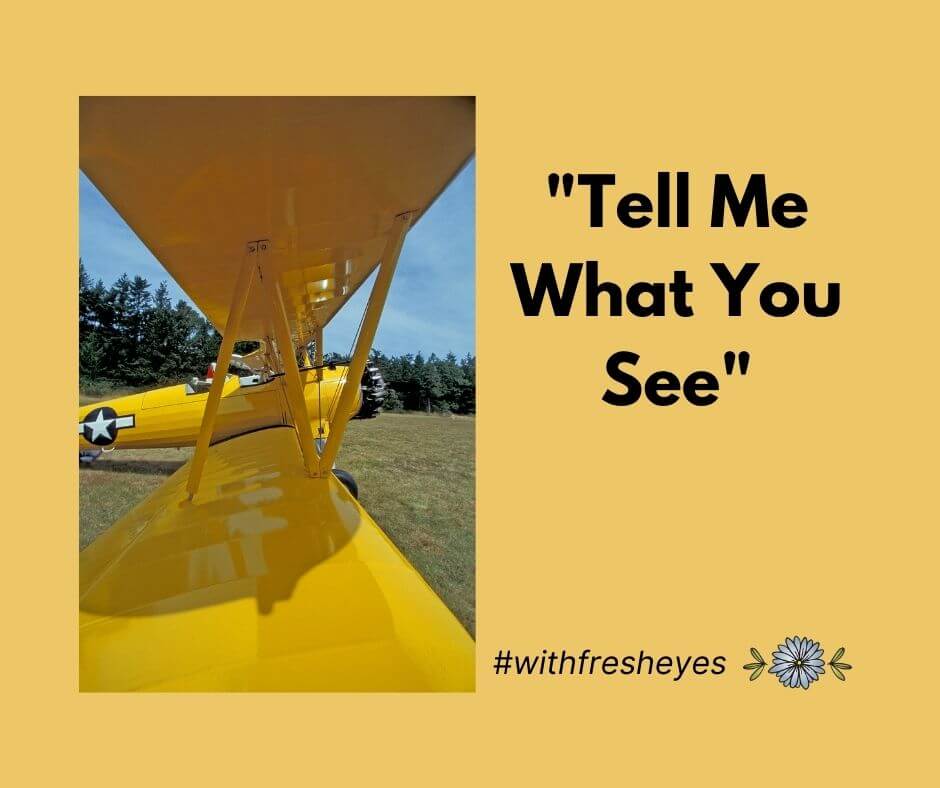
What did I see today? I saw an airplane.
Living in a big city near an air base and an international airport, we have lots of planes flying overhead. No, the noise doesn’t bother us. We’re the crazy people who look up at the sky. Preacher Creature can identify almost every plane.
I’m incredulous. “How can you do that?” I often ask.
He shrugs. He wanted to be a pilot in another life.
After my surgery that gave me Better Than Ever eyesight, P.C. was eager to share his love of aircraft with me. Before we moved to Arizona, we often traveled to Galesburg, Illinois for shopping. Every year, there is a National Stearman Fly-in and we would see the bright yellow planes do fly-bys as we neared the city. P.C. had a hard time keeping his eyes on the road as he tried to point out the planes to me. We both got excited when I exclaimed, “Yes! I see it.”
That was amazing. Before Better than Ever I wasn’t sure if I was seeing a plane, a bird, an eye floater, a bug on the windshield, or Superman. But suddenly, P.C. became skeptical. “Wait. What CAN you see?”
“A glint of yellow and some wings.”
His shoulders fell. He pointed to another plane. “That one. What do you see?”
I knew I would not see what he saw and that planes were much more important to him than they were to me. Why waste our time trying to get me to see as well as he could? “I would love to hear what you see. Describe the plane to me.” He did, throwing in all that pent-up information percolating in his brain that was far more than what his eyes saw that day. I saw much more too. I saw his vast knowledge, his passion for planes, and a wonderful love of aircraft lore and history.
(For more about the Stearman aircraft, read here.)
I wonder if that works for people situations too.
Fast forward five years. We came home one evening, disheartened. Someone we loved was facing a difficult life situation. “That was bad,” P.C. said.
“Tell me more,” I prompted.
“You were there. You saw it.”
A memory of Stearman planes buzzed my memory. “Tell me what you saw.”
His observations affirmed my own suspicions and clarified other details. Our conversation catapulted into a productive discussion of how we could best help our loved one.
Tell me what you see.
People surround us who feel unseen and left out. Internet articles abound that encourage church leadership to target groups otherwise overlooked, like singles, college students, and introverts. At the core, if we don’t walk in their world, we don’t immediately see their special needs. Or, like my visual understanding of an airplane, we might guess at what they need but, by trying to fix the problem, we fall so short and our clumsy attempts make us look even more uncaring.
I wonder if helping people effectively could start as simply as a prompt: “Tell me what you see.”
Jesus modeled that approach when he healed a blind man. He dealt first with the problem everyone else saw—the man’s blindness. But Jesus knew years of blindness caused another issue, unseen by the casual observer. After touching his eyes, Jesus asked, “Do you see anything?” The man replied, “I see people. They look like trees walking around.” I suspect the man was dealing with perception issues, the way his brain interpreted the visual data. Jesus touched the man again and this time, the man could see clearly. (See Mark 8:22-26.)
Imagine the results if we said, “Tell me what it’s like” to these groups of people:
- The homeless person
- The person of a different race or culture
- A widow
- Someone with a chronic disease
- A single person faithfully involved in church
- A mother with an autistic child
Once we saw life from their perspective, we would better understand what they face daily. And we’d be empowered to express compassion and work with them to find solutions for their special needs. And they, instead of wanting to escape to a group of people just like themselves, who “would understand me,” would feel welcomed into the larger group.
Each of us has special unique needs and long to be understood, seen, and accepted. And any of us can’t know all the details of what someone faces simply by observing or by “being there.” Once we have the humility to admit, “No I don’t know everything about the life you live. Please tell me what you see,” we’ll find it much easier to work together and seek common, workable solutions.
Paul’s take
Perhaps that’s what Paul had in mind when he wrote:
“Be completely humble and gentle; be patient, bearing with one another in love. Make every effort to keep the unity of the Spirit through the bond of peace.
Ephesians 4:3
Paul goes on to emphasize that God has given each person a customized package of gifts, abilities, and experience. God did this so that the body of Christ could be built up until we “reach unity in the faith and in the knowledge of the Son of God and become mature, attaining to the whole measure of the fullness of Christ (see Ephesians 4:13)”. Paul acknowledges that each of us is different and God intended it that way. Jesus designed the church to be made up of different backgrounds for the very purpose of bringing all those differences together to build each other up, make each other stronger, and in so doing, attempt great things for the kingdom of God.
If we’re going to work together, we have to stay together. And if we’re going to live with each other, we have to understand our distinctiveness. When we are better informed about our unique perspectives and special needs, we are better equipped to care for each other. And when we take care of each other, we all become stronger, strong enough to accomplish what is most important.
It can start with one simple sentence. “Tell me what you see.”

Leave a Reply